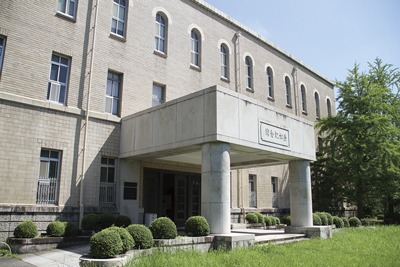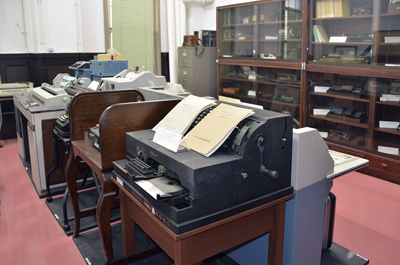

- Home >
- Satellite Museums >
- 2013 >
- Business Mechanization Exhibition, Research Institution for Economics and Business Administration, Kobe University
Business Mechanization Exhibition, Research Institution for Economics and Business Administration, Kobe University


![The nation's first 45 column punched-card sorter ( Kanegafuchi Jitsugyo [left] ), the 80 column punched-card sorter ( IBM [right] )](img/kobeUniv-03.jpg)
| Location | Research Institution for Economics and Business Administration, Kobe University, 2-1 Rokkodai, Nada-ku, Kobe-shi, Hyogo, 657-8501, Japan |
|---|---|
| Visitor information | Open to the public (visit by appointment) |
| Contact | Research Institution for Economics and Business Administration, Kobe University Tel.81+078-803-7270 |
28 business machines including the nation's first 45 column punched-card sorter are displayed at the Business Mechanization Exhibition in the Research Institution for Economics and Business Administration (RIEB), Kobe University. It provides an overview of the history of the mechanization of business administration in Japan through a wide variety of exhibits, most of which were acquired before 1959.
Of particular importance are the following exhibits:
・Punched-card sorter (Kanegafuchi Jitsugyo)
・Manual keypuches (IBM, Kanegafuchi Jitsugyo, Kobe Steel)
・Manual verifiers (IBM, Kanegafuchi Jitsugyo)
This exhibition also has the archival materials of the domestically produced business machines during WW2.
In coping with the U.S. embargo during WW2, three Japanese companies - Kanagafuchi Jitsugyo, Kobe Steel and Toshiba - started to manufacture business machines domestically. In particular, under the leadership of Yasutaro Hirai (1886-1970), a prominent professor of business administration at Kobe University, the nation’s first punched-card sorters were manufactured through cooperation between Kobe University and Kanagafuchi Jitsugyo (in part, Nakamoto Iron Works). The one displayed at the RIEB is the only domestically produced sorter that has survived until today.
Founded in 1919 as the Commercial Research Institute (CRI), Kobe Higher Commercial School (the initial forerunner of Kobe University), the RIEB boasts the longest history of all social science research institutes affiliated to national universities in Japan. The CRI took the initiative in the mechanization of business administration in 1941 and newly established the Institute for Mechanization of Business Administration (IMBA) in 1944, fostering the diffusion and education of the mechanization of business administration. The CRI (renamed the Economic Research Institute in 1945) and the IMBA integrated into the RIEB in 1949. As an initial leader of the mechanization of business administration, the RIEB has played a central role in its research and education, maintaining a rare collection of historical machines. This collection, ranging from rare business machines to educational material of mechanization of business administration, is open to the public
Of particular importance are the following exhibits:
・Punched-card sorter (Kanegafuchi Jitsugyo)
・Manual keypuches (IBM, Kanegafuchi Jitsugyo, Kobe Steel)
・Manual verifiers (IBM, Kanegafuchi Jitsugyo)
This exhibition also has the archival materials of the domestically produced business machines during WW2.
In coping with the U.S. embargo during WW2, three Japanese companies - Kanagafuchi Jitsugyo, Kobe Steel and Toshiba - started to manufacture business machines domestically. In particular, under the leadership of Yasutaro Hirai (1886-1970), a prominent professor of business administration at Kobe University, the nation’s first punched-card sorters were manufactured through cooperation between Kobe University and Kanagafuchi Jitsugyo (in part, Nakamoto Iron Works). The one displayed at the RIEB is the only domestically produced sorter that has survived until today.
Founded in 1919 as the Commercial Research Institute (CRI), Kobe Higher Commercial School (the initial forerunner of Kobe University), the RIEB boasts the longest history of all social science research institutes affiliated to national universities in Japan. The CRI took the initiative in the mechanization of business administration in 1941 and newly established the Institute for Mechanization of Business Administration (IMBA) in 1944, fostering the diffusion and education of the mechanization of business administration. The CRI (renamed the Economic Research Institute in 1945) and the IMBA integrated into the RIEB in 1949. As an initial leader of the mechanization of business administration, the RIEB has played a central role in its research and education, maintaining a rare collection of historical machines. This collection, ranging from rare business machines to educational material of mechanization of business administration, is open to the public
